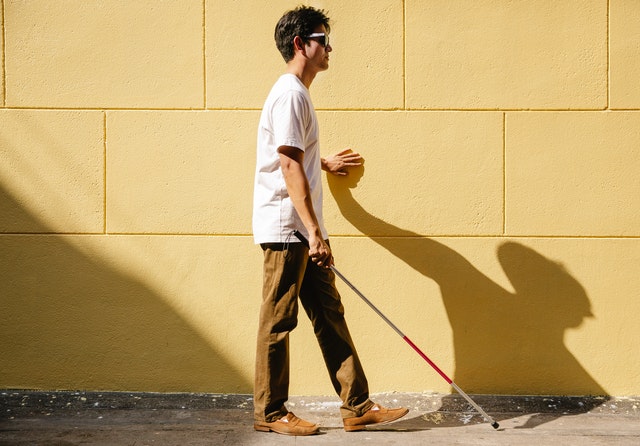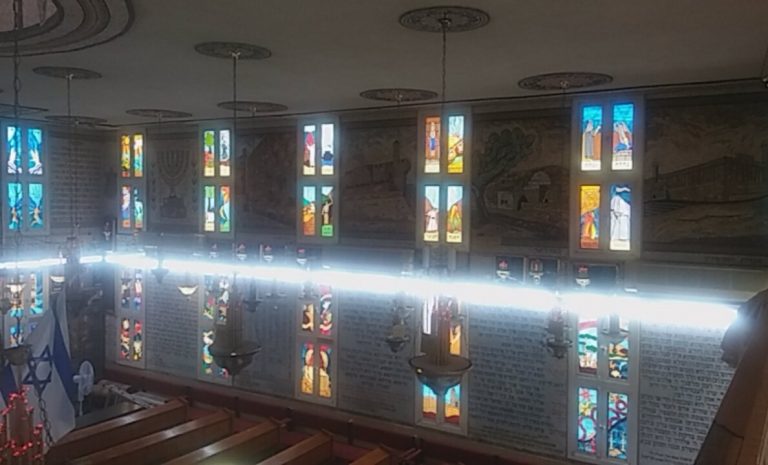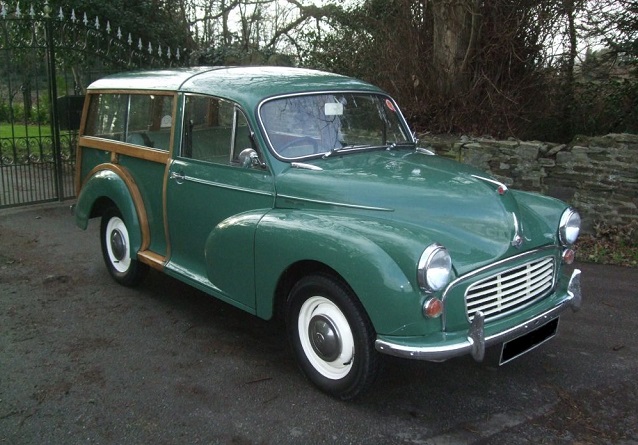Synagogues in Israel.
Synagogues & Religious Services in Israel
The office of the Chief Rabbinate is located in Jerusalem and it is the supreme rabbinic and spiritual authority for Judaism in Israel. There are two Chief Rabbis – one is Ashkenazi and the other is Sephardi. The Chief Rabbinate Council assists the two chief Rabbis who alternate in its presidency.


The Rabbinate has jurisdiction over many aspects of Jewish life in Israel; Jewish marriage and divorce, burials, Jewish conversion, kosher laws and kosher certification (kashrut), Jewish immigrants (olim) Jewish holy sites, Mikvaot (ritual baths) yeshivas and the Rabbinical Courts.
The Rabbincal Courts are part of Israel judicial system and are managed by the Ministry of Religious Services – HaMisrad LeSherutei Daat
There are Orthodox, Ashkenazi and Sephardi synagogues all over Israel. Reform (Progressive Judaism) and Conservative congregations in the main centers, have a growing English speaking membership. The LGBTQ community also offers religious activities for its members.
Please note that this page is being being updated
Synagogues in Ashkelon
Kehilat Netzach Yisrael
Kehilat Netzach Yisrael is the only non-orthodox synagogue in Ashkelon and offers an egalitarian, pluralistic and family-orientated approach to Judaism and caters to a range of languages, including Hebrew, English, Spanish and Russian. Members come from many different backgrounds: Sephardim and Ashkenazim daven there.
Central Afridar Synagogue
The Central Afridar Synagogue is on Zonabend Street, close to the Ganei Shimshon Hotel is also popular with the English speaking immigrant community. It was established by the South African community of Ashkelon in the 1950’s.
Central Barnea Synagogue
The Central Barnea Synagogue is on Yiftach Hagiladi Street and Kehilat Migdat on Tzahal Street are part of Chabad
Synagogues in Haifa
Members of our Haifa community wrote in and told us about their synagogues:
The Maor Yehuda Synagogue
By: The Hyman Family
Rabbi Shear-Yeshuv Cohen – Chief Rabbi of Haifa, describes Maor Yehuda Synagogue as “an exceptional community consisting of members of the Technion faculty, new immigrants,… as well as long-time Israelis from many different backgrounds. The project that they have undertaken is holy in every sense…”Established in 1978 by immigrants from English-speaking countries, from Switzerland and from France, who wished to carry on the positive aspects of Orthodox Jewish communal life found in the Diaspora in their new home in Israel.
For the first twenty years, the minyan was located in a variety of places, including the bomb shelter of a school. In 1989 the city of Haifa granted us a plot of land in Ramat Almogi on the ridge of Mount Carmel. Using funds provided by our members, private gifts, and some State grants, we built a synagogue and community room. Located at 13A Blitental Street, Ramat Almogi, between the Technion (The Israel Institute of Technology) and the University of Haifa, the synagogue serves the needs of 75 plus member families and the residents of more than 1,000 newly completed homes in the area. In addition, we welcome families spending a sabbatical at one of Haifa’s universities, high-tech campuses, or R&D centers. Mincha commences 20 minutes after candle lighting time, followed by Maariv. Shachrit on Shabbat is at 08:15.
For more information write to info@maoryehuda.org
The Kehilat Moriah Conservative Congregation
By: Rabbi Dubi Haiun
Kehilat Moriah is the oldest Conservative congregation in Israel. We are located at 7 Moriah Avenue, in the Ahuza neighborhood on Mt. Carmel (near the Horev Center). Moriah has more than 150 families and individuals as members.
We welcome all worshipers, and during holidays, especially Yom Kippur, Simhat Torah, and Purim – we are joined by many neighborhood residents. Others come to us to commemorate life-cycle events, from the birth of a child through Bar or Bat Mitzvah, weddings, and memorial services. Moriah also runs a number of social, cultural and educational activities, including outreach programs aimed at non-members as well as members. The doors of Moriah are open not only on Shabbat and holidays. The congregation hast two preschool classes, and to a flourishing youth group under the auspices of NOAM, the youth branch of the Israeli Conservative movement. We are extending our premises thus enabling us to expand our educational offerings. Finally, the idea of tikkun olam – a rabbinic concept that has come to mean the pursuit of human welfare and social justice – is an integral part of our worldview at Moriah, expressed in initiatives both ongoing and linked to events in the Jewish year. Contact the secretary for service times, membership fees for families and individuals at moriahaifa@022.co.il or telephone 04-8251245. The Moriah Conservative Congregation offers free membership to unemployed new immigrants.
Ohel Avraham
By: Carol Goldgeier
The synagogue of the Leo Baeck Education Center, Ohel Avraham, is affiliated with the Reform Movement (Israel Movement for Progressive Judaism).The synagogue holds Kabbalat Shabbat services at 5:30pm in the winter and 6:00pm in the summer. Most Shabbat mornings services are held at 9:30am. All services are open to the public. Social, cultural and educational events are held on an on going basis but change monthly. Likewise, we hold life cycle events including Bar and Bat Mitzva, Shabbat chatan and kallah, weddings, baby naming’s and more. Our members include olim from around the world as well as native Israelis. Annual dues are 900 shekels but a discount may be considered, upon review, for new immigrants. Our spiritual leader is Rabbi Gabby Dagan. For more information about the synagogue please call 04-8300542
Or Hadash
By: Or Hadash Secretariat
Or Hadash – The Lyons Center for Progressive Judaism, in the Ahuza neighborhood is a thriving Reform community in Israel. Since 1964 Or Hadash has been growing, and developing in size and scope. Every year more than 15,000 visitors encounter Israeli Reform Judaism through participating in at least one activity at Or Hadash. With a large variety of Tikun Olam programs, Or Hadash is a world-leading congregation in the field of Social Action.
With an average of 200 Bar/Bat Mitzvah ceremonies each year Or Hadash is a world leader in this field. The synagogue accommodates children with special needs and has performed hundreds of bar and bat mitzvahs for them. Building strong connections with Reform congregations in the US, Or Hadash maintains weekly contact with 800 families/rabbis/educators from dozens of sister congregations in the US. Several hundred Jews-by-choice have studied at Or Hadash. Every year, 50-60 people apply to convert to Judaism at Or Hadash – representing almost 30% of the total number of conversion students in Israel over the past 7 years. Since 1999 three Or Hadash pre-schools have been educating children in the spirit of Reform Judaism and hundreds of youngsters have been schooled in this way. With a steady Kabalat Shabbat minyan of 150-220 and more than 300 life cycle events per year, Or Hadash is the largest Reform synagogue in northern Israel. Or Hadash has a widespread educational outreach program. More than 4,000 pupils from 12 different elementary, junior high and high schools have the opportunity to become familiar with Reform Judaism. Over the past six years, 25,000 students from 37 different schools have visited Or Hadash. The only Israeli Religious Action Center office in the north of Israel is located inside the Or Hadash building. Legal aid is provided for thousands of new olim mainly from Ethiopia and Russia. Or Hadash in Haifa is a recognized institution and works in cooperation with the Haifa Municipality, with psychologists, social workers and dozens of volunteer organizations. The spiritual leader, Rabbi Dr. Edgar Nof, says “Members of our community are here for you. We have a special program for helping new immigrants: we provide Hebrew lessons, social and financial support and reduced membership fees. Joining Or Hadash is a wonderful way to become part of a vibrant community in Haifa. The State of Israel needs Reform Judaism and by joining Or Hadash, you are supporting the establishment of the ethical, egalitarian and democratic values of Reform Jewish life in Israel.”
Or Hadash has a large English speaking congregation.
For more information, in English, contact:
Or Hadash”, The Lyons Center for Progressive Judaism (R.Soc.)
55 Hantke St.
P.O.Box 3711, Haifa 31036
Tel: 972-4-8343905/6
E-mail: com1@or-hadash.org.il
Synagogues in Modiin
With thanks to the Modiin Municipality
| NAME | TRADITION | COMMENTS |
| Heichal Michael Nachum | Yemenite | |
| Heichal Shmuel | Sephardi | |
| Kehilat Yachad | Combined | |
| Achdut Modiin | Ashkenazi | |
| Achva VeReut | Sephardi | |
| Adir Bamarom | Ashkenazi | |
| Amalei Shir | Yemenite | |
| Ariel | Ashkenazi | |
| Ayelet HaShachar | Ashkenazi | |
| Beit Chabad | Ashkenazi | |
| Bei HaRambam | North African | |
| Ben Porat Yosef | Sephardi | |
| Buchman | Sephardi | |
| Choshen Modiin | Ashkenazi | Rosh Hashanah & Yom Kippur only |
| Darkei Noam | Ashkenazi | |
| Dimri | Sephardi | |
| Dvir Modiin | Sephardi | |
| Etz Hayim | Sephardi | Indian |
| Gan Barkan | Sephardi | |
| HaBen Ish Chai | Sephardi | |
| HaKehilati HaMaccabim | Combined | |
| HaMeginin | Ashkenazi | |
| Kehilat HaShimshoni Synagogue | Ashkenazi | |
| Lechu Nerana | Ashkenazi | Egeletarian |
| Meir Modiin – Mishkan Gershon | Ashkenazi | |
| Kehilat Meitar | Sephardi | North African |
| Shivtei Yisrael | Ashkenazi | |
| Tiferet Chen | Ashkenazi | |
| Yachad | Ashkenazi | |
| Yozma | Reform | |
| Yedid Nefesh | Masorti | |
| Mishkan Shalom – Edmond Safra | Yemenite | |
| Kipodan | Ashkenazi | |
| Kol Sasson | Yemenite | |
| Kol Yaakov | Sephardi | |
| Kol Yehuda | Moroccan | |
| Lev Achim | Ashkenazi | |
| Lev Modiin | Carlebach | Lots of Anglo families |
| Marom Yigal | Moroccan | |
| Menorat Avner | Ashkenazi | |
| Merkaz Modiin | Ashkenazi | |
| Mesoat Neirah | Sephardi | |
| Migdal David | Sephardi | |
| Achva | Masorti | |
| Darkei Zion | Ashkenazi | |
| El-Ad | Ashkenazi | |
| Mishkan Eliezer | Moroccan | |
| Mishkan HaKohanim | Sephardi | |
| Mishkan Rafael | Sephardi | |
| Mishkan Shalom | Yemenite | |
| Mishkan Shlomo | Ashkenazi | |
| Moriah | Ashkenazi | |
| Odaya Zechor LeAvraham | Ashkenazi & Spehardi | |
| Ohel Rachel | Moroccan | |
| Or Modiin | Sephardi | |
| Orot HaKramim | Ashkenazi | |
| Renana | Combined | Family orientated |
| Reut | Ashkenazi | |
| Shaarei Yerushalayim | Sephardi | |
| Shalhevet HaMakabim | Masorti | |
| New Beit Chabad Ohel Menachem | Ashkenazi | |
| Titora | Ashkenazi | |
| Tzi’erei HaGiva | Ashkenazi | |
| Tzi’erei Modiin | Ashkenazi | |
| Tzi’eri HaKramim | ||
| Ubecharta BeHayim | Sephardi | |
| Minyan at the Irya | Sephardi | Rosh Hashanah & Yom Kippur only |
| Mishkan Elazar | North African | |
| Uri Tzafon | Yemenite | |
| Yakir Efraim | Ashkenazi | |
| Yeshivat Hesder Meir Harel | Yeshiva | |
| Yosef Li | Sephardi | |
Synagogues in Raanana
Thanks to the Raanana Municipality for sending us this list of synagogues.
| TRADITION | ADDRESS |
NAME |
| Sephardic | Kiryat Sharett | Ahava V’Achva |
| 50 Hapalmach Street | Ahavat Zion | |
| Ashkenazi | 10 Ramchal Street | Ohel Moed |
| Yemenite | Migdal Street | Or Zion |
| Kiryat Sharett | Orach Chaim | |
| Yemenite | Hahistadrut Street | Achim |
| Ashkenazi | 1 Haprachim Street (Aviv High School) | Achva |
| Sephardic | 55 Ravutzki Street | El Olam |
| Ashkenazi | 33 Sheshet Hayamim Street | Kehilat Ariel |
| Ashkenazi | Bilu School | Bilu |
| Yemenite | 2 Ben Zakhai Street | Beit Aharon |
| Sephardic | Fisher | Beit El |
| Sephardic | 8 Herzl Street | Beit Ari |
| Ashkenazi | 101 Ahuza Street | The Great Synagogue |
| Yemenite | 10 Ramchal Street | Beit Ya’akov |
| Sephardic | 41 Hatchiya Street | Bar Yochai |
| Sephardic | Ibn Gvirol Street | Birkat Yitzchak |
| Ashkenazi | Motzkin Street | Gan Aliyah |
| Ashkenazi | Aharon Katzin Street | Heichal Binyamin |
| Ashkenazi | 11 Har Sinai Street | Heichal Habracha |
| Sephardic | Ramchal Street | Heichal Zion |
| Ashkenazi | Sheshet Hayamim St.- Ariel School | Haminyan Hechadash |
| Ashkenazi | Kfar Batya | Haminyan Hakehilati |
| Ashkenazi | 18 Brandeis Street | Hapoel Hamizrachi |
| Ashkenazi | 2 Tel Chai Street – Inside the school | Chorev |
| Ashkenazi | 16 Hanegev Street | Chabad |
| Ashkenazi | Hafetz Haim Street inside the school | Yavneh |
| Yemenite | Hapalmach Street | Yemin Moshe |
| Sephardic | Brandeis Street | Yeshurun |
| Ashkenazi | Kfar Batya Youth Village | Kfar Batya |
| Ashkenazi | 5 Herzl Street | Lechu Neranena |
| Yemenite | Kiryat Sharett | Migdal Tzedek |
| Sephardic | Katzenelson Street | Magen David |
| Ashkenazi | 184 Ahuza Street | Moriah |
| Yemenite | 10 Shvartz Street | Moreshet Avot |
| Sephardic | Kiryat Sharett | Ma’ayan Hasimcha |
| Sephardic | Shvartz Street | Mikdash Melech |
| Yemenite | Rasco | Mekor Chaim |
| Ashkenazi | Ostrovsky Street | Aliyah Absorption Center |
| Sephardic | Ostrovsky Street | Beit Yisrael Absorption Center |
| Yemenite | Rasco | Nachalat Achim |
| Yemenite | Rasco | Netzach Yisrael |
| Ashkenazi | Kiryat Sharett | Adat Yisrael |
| Ashkenazi | Bialik Street | Adat Yisrael |
| Ashkenazi | 7 Abarbanel Street | Adat Bnei Yisrael |
| Migdal Street | Olei Bavel | |
| Sephardic | Migdal Street | Olei Luv |
| Shmuel Hanagid Street | Etz Chaim | |
| Ashkenazi | Etzion Street | Etzion Street |
| Ashkenazi | Arlozorov Street | PAI Poalei Agudat Yisrael |
| Ashkenazi | 11 Brenner Street | Tzur Yisrael |
| Sephardic | 90 Herzl St. – In the Retirement Home | Tzimmerman |
| Reform | 94 Pardes Meshutaf | Kehilat Raanana for Progressive Judaism |
| Ashkenazi | 108 Ravutzki Street – Open University | Kehilat Netivot |
| Ashkenazi | Degania Street | Kiryat Eliyahu |
| Yemenite | 28 A’ Shabazi Street | Rachel V’Leah |
| Ashkenazi | Bilu Street | Re’ut |
| Yemenite | Shchunat Ovdim | Shabazi |
| Ashkenazi | Har Sinai Street | Shivtei Yisrael |
| Sephardic | Kiryat Sharett | Shevet Achim |
| Yemenite | Neot Sadeh | Sha’ar Harachamim |
| Carlebach | 159 Ahuza (Beit HaNoar, Cr.HaSharon) | Kinor David |
A complete list of synagogues in Israel can be found (in Hebrew) on www.kipa.co.il/synagogue
You may like these…
- The Jewish holidays and festivals
- Tips for an Easy Fast
- Recipes for Jewish Holidays
- The Tunisian Synagogue in Akko
It’s easy! Please tell us about the synagogue in your area via the comment box below.
Haifa’s Holiday of Holidays Festival
Reading Time: 4 minutes
The Haifa Festival of Festivals or Holiday of Holidays – an annual celebration.
Hebrew: חג החגים
What’s on in Haifa? Sometimes referred to as the Haifa Festival of Festivals and sometimes the Haifa Holiday of Holidays Festival (HEBREW – חג החגים), this annual event takes place in Haifa in December. Although much needed, we all pray the rain will stay away and the winter weather will be pleasant enough for this unique outdoor event not to be interrupted in any way.


A few weekends of festivities, cultural activities, markets and fun and events celebrate the three monotheistic religions that live in mutual harmony, cooperation, tolerance and respect in Haifa. Jews, Christians and Moslems are celebrating their holy days and in Haifa, everyone puts their religious and cultural differences aside, and gets together to enjoy this fun-filled event.
Now in it’s 28th year, the festival has grown in size and popularity. The festival hi-lights the unique flavor of Haifa and its residents. Yona Yahav (previous Mayor of of Haifa) aptly described the Festival as one “without boundaries of culture and religion. Just show up and rejoice!”
2021 Festival Dates
December 2-4, 9-11 & 16-18
Location
Since 2018 The Festival of Festivals Holiday of Holidays is held in the German Colony. The incumbent, and first, lady Mayor of Haifa – Dr. Einat Kalisch-Rotem moved the main festival events from the Wadi NisNas neighborhood to the German Colony. This change in venue has been a success allowing ten’s of thousands of visitors to the Festival.
For first time visitors to Haifa, the German Colony is nestled between the Haifa Port and the Bahai Temple. The festival is focused along Ben Gurion Boulevard and many performances are held at Beit HaGeffen Cultural Center on the corner of Allenby and Hatzionut Streets.
Wad NisNas – a 10-15 minute walk (no hills) from the Germany Colony, is a quaint place to visit. If you have the patience to stand in a long queue, Falafel Hazkaynim, Falafel Michel and Falafel George have a reputation for the best falafel in Haifa. These ‘falafelerias’ have been battling for the falafel crown for years. They have been featured on Travel-Israel television and culinary programs with Yishai Golan, Yisrael Aharoni and Hila Alpert. Falafel Orion on Hertzliya street serves a great falafel too. If you’re into hummus; Abu Shakker, Hummus Abu Marwan are just a few of the very best local ‘hummuserias’.
Performances, exhibitions and other Holiday of Holiday events also take place at:
- The Rappaport Center at the Haifa Auditorium
- The Tikotin Japanese Museum
- The Studio Theater at Bet Hecht
- The St. Johns Church.
- Haifa Art Museum
- Haifa City Museum
Transport guide
How to get to the festival? By foot, by car, by bus, by Metronit or by taxi:
Walk through Haifa’s many alleys and stairways that run from Mount Carmel down to Ben Gurion Boulevard. Starting from Yefe Nof Street in the Central Carmel the Gadera stairs, near the Dan Panorama Hotel, descend. Walk down the stairs to the German Colony. It’s a 30+ minute walk to the Festival of Festivals from the Central Carmel. There are hundreds of stairs – don’t do this if you have knee problems but if you can, it’s a wonderful way for you to meander around Haifa, take in the spectacular views, see the suburbs and feel the Haifa vibe.
Haifa runs a limited bus and Metronit service on Saturdays so check on the Egged website or apps like Efobus and Moovit for updates.
Festival Parking
Parking in the German Colony is available but remember that it will be in serious demand during the festival. These are the main parking zones close by.
- Migdal HaNeviim
- HaParsim St. 3 & 16
- Ben Gurion 6 & 18
- HaNamal St.
- HaAtzmaut 67
- HaGanim 21
- Y.L. Peretz St.
- Lavontin St.
- Herzliya St.
- Kadoshei Bagdad St.
Corona Updates
Current Ministry of Health directives will apply to all indoor events. Have your Green Pass on hand.
What you can expect to see at the festival
Ben Gurion Blvd, the center of the festival is flanked on both sides with wonderful restaurants and coffee shops and some free performances are held here.
Market stalls along Ben Gurion Blvd., sell all manner of craft and flea market items, toys, food and drink, handmade jewelry and items of clothing. Home made pita, labane, koubbeh, kebabs, zaatar, mejadra and tabbouleh are also on sale. Sample delicious home made nougats, peanut brittle, halva and knafeh. For the kids, sticky toffee apples are a must. Hot legumes, corn on the cob and roasted chestnuts are also on sale. A glass of freshly squeezed pomegranate, orange or carrot juice will quench your thirst for about 10 shekels.
The Christmas lights are on every evening and when you look up you will also have a fabulous night view of the Bahai Temple.
Bet Hageffen – the Jewish Arab Cultural Center hosts numerous performances and exhibitions and this year is no exception.
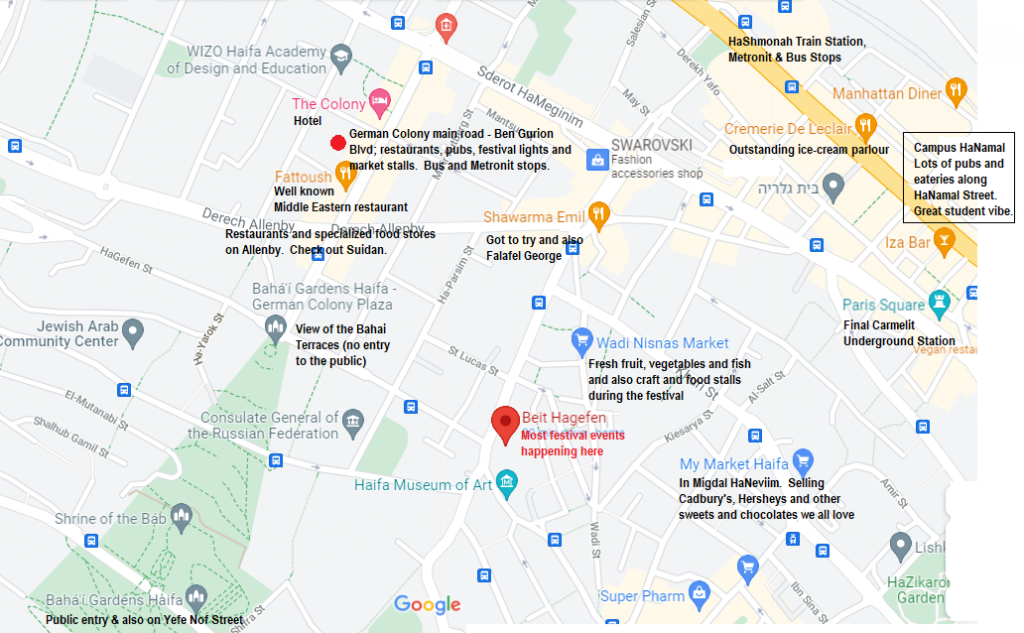

Top Festival Tips
- Don’t be shy to bargain – it’s part of the Middle Eastern culture
- Keep your wallet and mobile phone in a safe place
- Wear comfortable shoes – plenty of walking
- Some stalls will take credit cards but not all, so bring plenty of cash
If the weather is fine and you’re coming to Haifa for the day, you might want to combine your visit to the Festival with other activities. Haifa’s beaches stretch for miles and while it might be too cold for a dip in the ocean, a walk along the promenade and Park Hecht can be invigorating. A selection of cafes and restaurants on the boardwalk are a great way to relax and enjoy the day, the waves and the ocean breeze. You might also want to take in a visit to the Druze Villages, the Haifa Zoological Gardens or the view from the Bahai Garden main entrance – you will need a car to get to these destinations.
- Israel parking regulations explained
- Traffic violations and parking fines
- Road and parking signs
- Parking for disabled drivers
- Planning a trip or touring? Tour and travel Israel with us
See you there!
Israel Railways and Train Services
Israel Railways & Train Services.
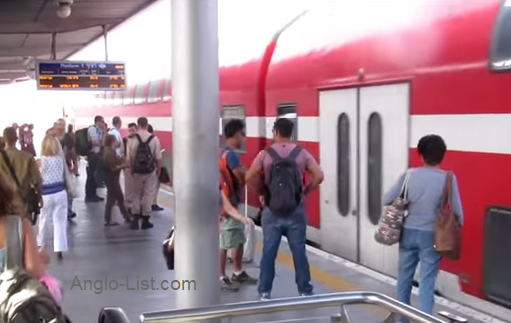

Israel Railways operates the only train service in Israel. Trains run from Nahariya in the north to Beer Sheva in the south. Trains also service the Karmiel, Bet Shean, the Sharon, Modiin, Jerusalem and Dimona to the East. Click here for train stations route map…
Northern Stations
The northern most station is Nahariya. There is also a station in Akko. In 2016, the line serving Afula from Haifa was completed.
There are 4 main stations in Haifa
- Carmel Beach (Merkazit Hof Hacarmel) – opposite the Central Bus station, next to the Haifa beach area, MATAM (Hi-tech center) serving Southern Haifa
- Bat Galim – next to the old Egged central bus station, close to Rambam Hospital.
- Hashmona Central station – serving Downtown Haifa, the Haifa Port on Haaztmaut Road and the government offices on Pal Yam (the Bullet Building – Ministry of the Interior, the Courts, Bituach Leumi and other public offices)
- The Haifa Bay Station (Merkazit Lev Hamifratz) – adjacent to the Central Bus Station, at the Check-post and serving the Cinemall and Haifa Bay industrial area and the smaller stations of the Krayot and those travelling north.
Binyamina Stations
The Binyamina station is a main junction, between Haifa and Tel Aviv, here you can switch trains and connect to the main north and southbound lines around the country and all the way to Beer Sheva.
Tel Aviv
Tel Aviv has 4 main train stations which connect to the North as well as the East – The Sharon Plain, Ben Gurion International Airport and Modiin, Jerusalem and to the South; Rishon le Zion, Beer Sheva and Ashkelon
- Tel Aviv University & Show Grounds – also known as Ramat Aviv. In Hebrew: Universita Ve Gan Hairuim
- Tel Aviv Center-Savidor – also known as Arlozorov. In Hebrew: Tel Aviv Merkaz-Savidor
- Tel Aviv HaShalom – also known as Azrielli.
- Tel Aviv HaHagana
Jerusalem
There are 2 main train stations in Jerusalem
- Biblical Zoo
- Malha (by the mall)
There is no direct line from northern Israel to Jerusalem. To do so, you need to take the train to Ben Gurion International Airport and then connect to the Jerusalem stations.
Raanana
Modiin
Modiin is the last stop on the direct Nahariya – Modiin Line (including Ben Gurion International Airport). If you need to get to Modiin, from other parts of the country, you need to swap trains in Tel Aviv at Savidor, HaShalom or HaHagana
Ben Gurion International Airport
Getting to and from Ben Gurion International Airport (NATBAG) is not a problem. The direct train from Nahariya in the north to Ben Gurion Airport (and then onto Modiin) runs frequently into the early hours of the night. You need to swap trains in Tel Aviv at Savidor, HaShalom or HaHagana if you are coming from other parts of the country. The train runs from around 6am till 4am the following morning.
(Due to work on the lines the train to the airport does not currently run on Friday’s – 2021). Shuttle services are available from Tel Aviv. Consult the Israel Railways website for updates.
At times during the coronavirus, the station at Ben Gurion International Airport was shuttered. Before you set out, make sure that the train is scheduled to stop at the airport.
Train to Eilat
A fast train route between Tel Aviv and Eilat has been approved. There is still no expected commencement or completion date.
The proposed 350-kilometer track will connect the center of Israel with Eilat, the best scuba diving, Red Sea resort city and port. It is estimated that the train will travel at some 250 kilometers per hour.
In the meantime you can take a train to Beer Sheva and then a bus onto Eilat.
Wheelchair Access
Unfortunately, not all the train stations in Israel, are wheelchair friendly. You need to contact Israel Railways and coordinate your journey with them and they will arrange for wheelchair assistance for you.
Top Tips
- If it is possible to make use of a return ticket, then do so. There is a 10 per-cent discount on the ticket price if you purchase a return ticket. The discount is only applicable if you use the Rav-Kav multi-transport, smart-card.
- Train announcements at the stations are made in Hebrew and English
- “Next Stop” announcements in the trains are also made in Hebrew and English. They are also displayed on a monitor in each coach. Ask a fellow passenger if you are unsure.
Contact
Please note that Anglo-List does NOT provide information regarding schedules, ticket rates, stations, train accessibility and more.
Dial *5770 for the Information and Customer Service Call Center at Israel Railways.
Carmel Tunnel & Road No. 6 – Two toll Roads.
Reading Time: 3 minutes
Israel’s 2 Toll Roads – The Carmel Tunnel & Road No. 6
Hebrew: כביש 6 ומנהרות הכרמל
The Carmel Tunnel
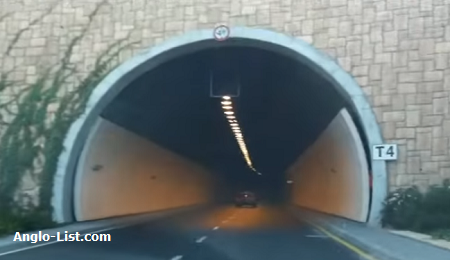

The tunnels provide easy access to the following Haifa shopping centers:
- Haifa Mall at the southern entrance to Haifa
- Castra Mall at the southern entrance to Haifa
- The Grand Canyon in Neve Sha’anan
- The Cinemall at the Checkpost
The tunnels also provide easy access to Highway No. 1 – the coastal highway as well as to the new Sammy Offer Stadium in Tirat HaCarmel, also at the southern entrance of Haifa
Carmel Tunnel Fees & Toll
- The Checkpost at the northern entrance of Haifa –> Grand Canyon segment
- The Grand Canyon –> The southern entrance of Haifa
Payment can be made in the following 3 ways:
- Cash at the toll booth
- Video tolling using automatic number plate recognition for subscribers
- Video or transponder tolling for Highway 6 subscribers
The current rates
Prices correct as at December 2015 and are subject to change.
| One Segment | Two Segments | |
| Private vehicle | 8.69 ₪ | 17.38 ₪ |
| Public transport | 26.07 ₪ | 52.14 ₪ |
| Trucks | 43.45 ₪ | 86.90 ₪ |
Please note: The navigational app – Waze – does not work in the Carmel Tunnels
The complex system of roads surrounding the tunnels is affectionately called ‘the spaghetti highway’ by Haifa residents.
- Plan your next trip with these transport resources
- How do you say ‘public transport’ in Hebrew
- Road and traffic signs and road markings
Highway 6 – Kvish Shesh
Hebrew: כביש 6
Highway 6 or Kvish Shesh is a major highway and toll road in Israel. The highway runs from the north to the south of the country starting at Ramat Menashe (between Yokneam and Zichron Yaakov) finally connecting to Highway No. 4 in the south of the country near Beer Sheva. The road is 140 km long, all of which is a freeway.
Unlike the Carmel Tunnels, there are no toll booths. Highway 6 uses a system of cameras and transponders to toll vehicles automatically. For vehicles without a transponder, an automatic license plate recognition system is used. Monthly statements are mailed to users. The pricing scheme for Highway 6 is based on the number of segments a driver passes in a given trip. Each segment is the road span between two interchanges.
How much does it cost to use the toll road?
The pricing for non-subscribers up to 3 segments, is 19.39 NIS, for 4 segments – 23.68 NIS and for 5 or more segments – 33.23NIS. An additional fee is paid when driving through the ‘northern segment’ (NS), the cost of which is additional 13.28NIS. Pricing for motorcycles and heavy vehicles is different. If a license plate is not located in Highway 6’s database then the bill is sent to the owner of the vehicle according to the car registration with the Israeli Ministry of Transportation. Prices correct as at December 2015 and are subject to change.
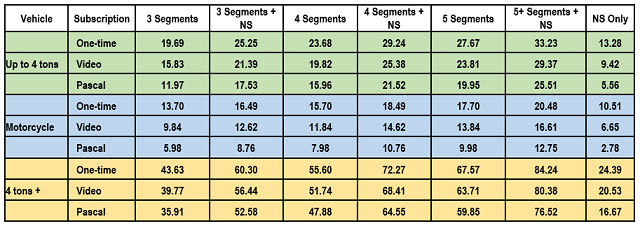

Renting a vehicle? Verify toll road rates with your car rental company. Rental companies also charge an additional administration fee.
Payments & Late Fees
The bill for Kvish Shesh is sent to you and includes a payment deadline. Should you exceed the deadline, you will be charged late-fees. The late-fees are steep so make sure you pay your bill on-time. Bills can be paid online on the Kvish 6 website or at the post office or via a Kvish 6 customer service rep.



